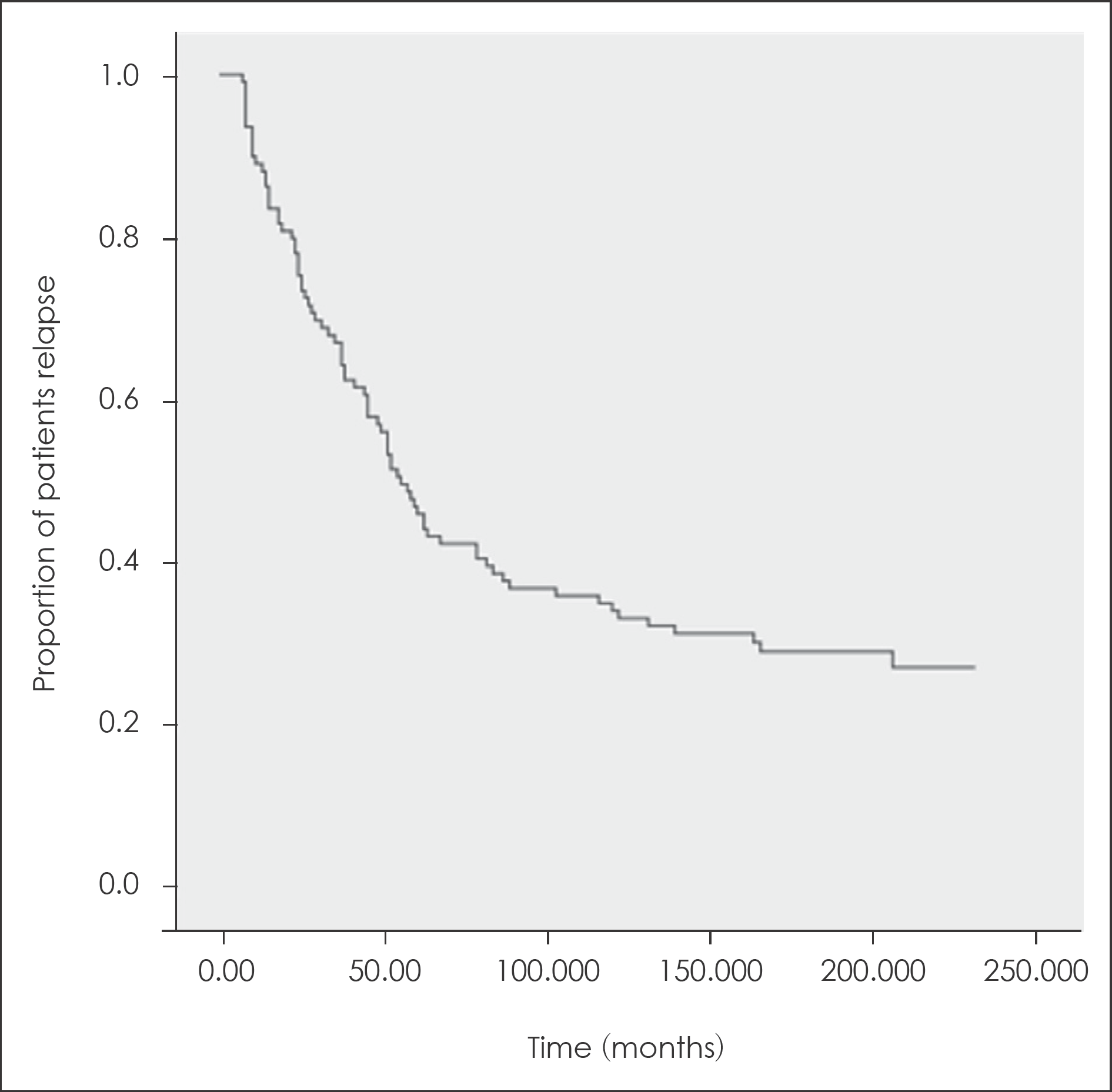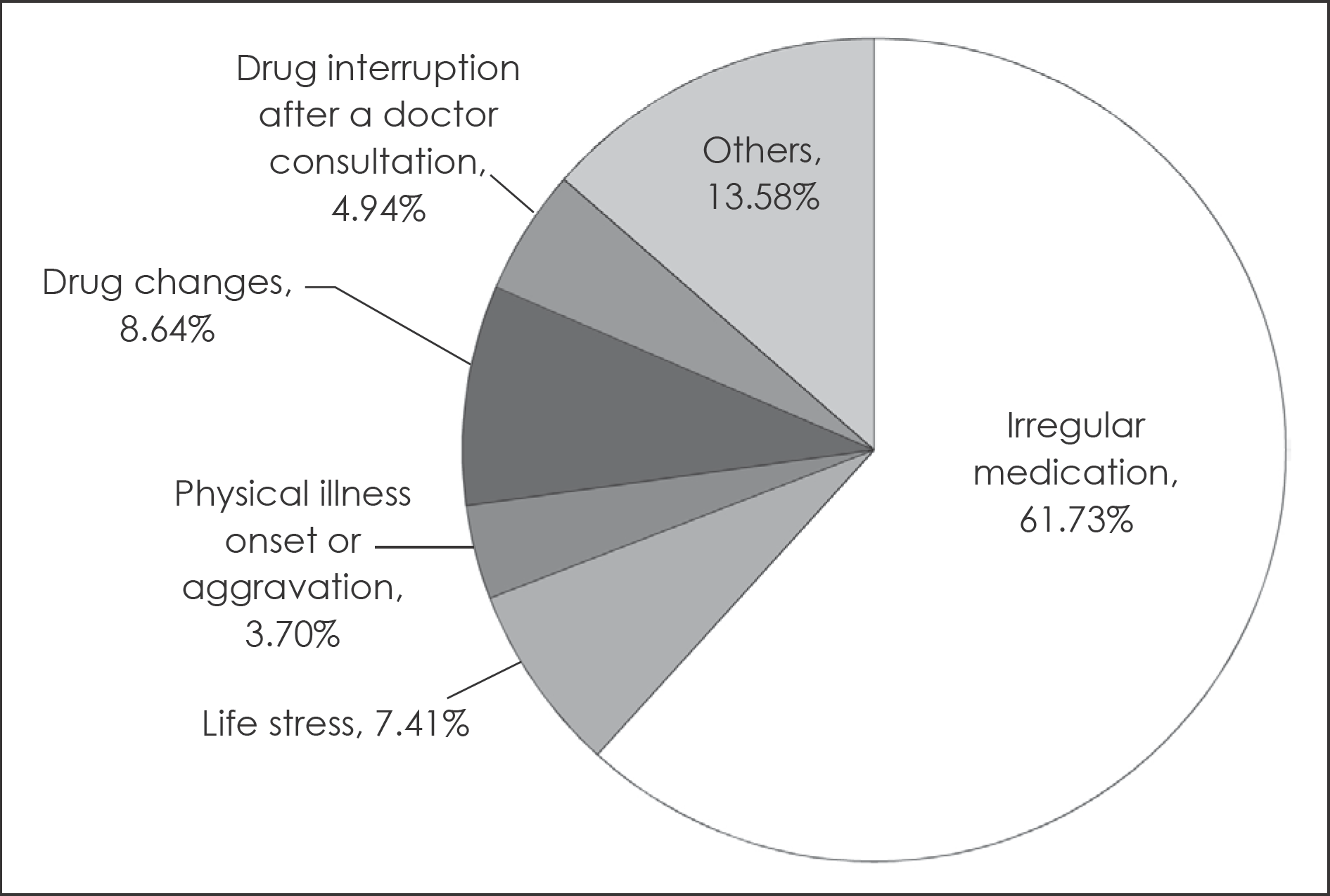Abstract
Objectives
The purpose of this study is to investigate the factors affecting recurrence in patients with schizophrenia received more than 10 years of longterm treatment.
Methods
The medical records of longterm followup patients with the diagnosis of schizophrenia from department of psychiatry, Inha university hospital for more than 10 years were reviewed. The recurrence was defined as the re-emergence or aggravation of psychotic symptoms after maintenance treatment during 6 months.
Results
Of the 110 patients who were included in the study, 78 patients were recurred. Half of the patients were experiencing at least 1 recurrence within six years. After adjustment of sociodemographic variables, female, poor drug compliance, younger baseline age, shorter duration of illness and longer duration of hospitalization at first admission were significantly related to an increased likelihood of recurrence. The most common stressor of recurrence was irregular drug taking (61.73%).
REFERENCES
1). Gelder M, Andreasen N, López-Ibor J, Geddes J. New Oxford Text-book of Psychiatry. Oxford: Oxford University Press;2000.
2). Pigott TA, Carson WH, Saha AR, Torbeyns AF, Stock EG, Ingeni-to GG. Aripiprazole for the prevention of relapse in stabilized patients with chronic schizophrenia: a placebo-controlled 26-week study. J Clin Psychiatry. 2003; 64:1048–1056.
3). Almond S, Knapp M, Francois C, Toumi M, Brugha T. Relapse in schizophrenia: cost, clinical outcomes and quality of life. BJP. 2004; 184:346–351.
4). Knapp M, Mangalore R, Simon J. The global cost of schizophrenia. Schizophr Bull. 2004; 30:279–293.
5). Doering S, Müller E, Köpcke W, Pietzcker A, Gaebel W, Linden W, et al. Predictors of relapse and rehospitalization in schizophrenia and schizoaffective disorder. Schizophr Bull. 1998; 24(1):87–98.

6). Goodpastor WA, Hare BK. Factors associated with multiple readmissions to an urban public psychiatric hospital. Hosp Community Psychiatry. 1991; 42:85–87.

7). Lin CH, Chen WL, Lin CM, Lee MD, Ko MC, Li CY. Predictors of psychiatric readmissions in the short- and longterm: a population-based study in taiwan. Clinics (Sao Paulo). 2010; 65:481–489.

9). Gilbert PL, Harris MJ, McAdams LA, Jeste DV. Neuroleptic with-drawal in schizophrenic patients: a review of the literature. Arch Gen Psychiatry. 1995; 52:173–188.
10). Gitlin M, Nuechterlein K, Subotnik KL, Ventura J, Mintz J, Fogel-son DL, et al. Clinical outcome following neuroleptic discontinu-ation in patients with remitted recent-onset schizophrenia. Am J Psychiatry. 2001; 158:1835–1842.

11). Ayuso-Gutiérrez JL, del Río Vega JM. Factors influencing relapse in the longterm course of schizophrenia. Schizophr Res. 1997; 28:199–206.

12). Gaebel W. Towards the improvement of compliance: the significance of psychoeducation and new antipsychotic drugs. Int Clin Psychopharmacol. 1997; 12(Suppl 1):S37–42.
13). Hudson TJ, Owen RR, Thrush CR, Han X, Pyne JM, Thapa P, et al. A pilot study of barriers to medication adherence in schizophrenia. J Clin Psychiatry. 2004; 65:211–216.

14). Valenstein M, Blow FC, Copeland LA, McCarthy JF, Zeber LE, Gillon L, et al. Poor antipsychotic adherence among patients with schizophrenia: medication and patient factors. Schizophr Bull. 2004; 30:255–264.

15). Lacro JP, Dunn LB, Dolder CR, Leckband SG, Jeste DV. Prevalence of and risk factors for medication nonadherence in patients with schizophrenia: a comprehensive review of recent literature. J Clin Psychiatry. 2002; 63:892–909.
Table 1.
Sociodemographic and clinical characteristics of the subjects
| Total | No recurrence | Recurrence | χ2 | p-value | |
|---|---|---|---|---|---|
| N (%) | N (%) | ||||
| Whole Sample | 110 | 32 (29.1) | 78 (70.9) | ||
| Gender | |||||
| Male | 53 | 19 (59.4) | 34 (43.6) | 2.265 | 0.132 |
| Female | 57 | 13 (40.6) | 44 (56.4) | ||
| Education | |||||
| 0-12 | 66 | 16 (64.0) | 50 (66.7) | 0.059 | 0.807 |
| >12 | 34 | 09 (36.0) | 25 (33.3) | ||
| Married | |||||
| No | 79 | 23 (74.2) | 56 (71.8) | 0.064 | 0.800 |
| Yes | 30 | 08 (25.8) | 22(28.2) | ||
| Job | |||||
| No | 55 | 17 (53.1) | 38 (48.7) | 0.176 | 0.675 |
| Yes∗ | 55 | 15 (46.9) | 40 (51.3) | ||
| Economic status | |||||
| High | 36 | 08 (25.8) | 28 (35.9) | 1.021 | 0.312 |
| Low | 73 | 23 (74.2) | 50 (64.1) | ||
| Inpatient or outpatient on baseline | |||||
| Outpatient | 49 | 17 (53.1) | 32 (41.0) | 1.345 | 0.246 |
| Inpatient | 61 | 15 (46.9) | 46 (59.0) | ||
| Drug compliance | |||||
| Poor | 57 | 07 (21.9) | 50 (64.1) | 16.206 | <0.001 |
| Good | 53 | 25 (78.1) | 28 (35.9) | ||
| Comorbid | |||||
| No | 103 | 29 (90.6) | 74 (94.9) | 0.687 | 0.407 |
| Yes | 7 | 03 (9.4) | 04 (5.1) |
Table 2.
Comparison between no recurred schizophrenia and recurred schizophrenia
| No recurrence | Recurrence | t | p | |
|---|---|---|---|---|
| Mean (SD) | Mean (SD) | |||
| Age of onset | 27.94 (11.62) | 25.30 (7.24) | 1.175 | 0.247 |
| Age (year)∗ | 35.97 (11.89) | 30.40 (8.75) | 2.397 | 0.021 |
| Duration of illness (year)∗ | 08.30 (7.83) | 05.00 (6.18) | 2.318 | 0.022 |
| Alcohol history∗ | 00.73 (2.10) | 03.99 (24.49) | -0.438 | 0.663 |
| Smoking history∗ | 00.86 (1.32) | 01.61 (7.30) | 1.088 | 0.724 |
| Body mass index (BMI)∗ | 23.83 (7.64) | 23.60 (4.27) | 0.140 | 0.889 |
| Global Assessment of Functioning (GAF)∗ | 43.44 (15.89) | 34.88 (15.59) | 2.599 | 0.011 |
| Duration of hospitalization at first admission | 15.81 (21.25) | 38.81 (30.99) | -3.839 | <0.001 |
Table 3.
Distribution of recurrence frequencies
| Number of recurrence | Number of subject (N) | Percent (%) |
|---|---|---|
| 0 | 32 | 29.1 |
| 1 | 34 | 30.9 |
| 2 | 24 | 21.8 |
| 3 | 13 | 11.8 |
| 4 | 06 | 05.5 |
| 7 | 01 | 00.9 |
Table 4.
Relationships between recurrence and sociodemographic and clinical characteristics
| Adjusted odd ratio∗ | 95% CI | p | |
|---|---|---|---|
| Gender | |||
| Male | 1.0 | ||
| Female | 4.19 | 01.29-13.64 | 0.017 |
| Age of onset | 1.03 | 0.94-1.11 | 0.533 |
| Education | |||
| 0-12 | 1.0 | ||
| > 12 | 1.07 | 0.38-2.99 | 0.905 |
| Married | |||
| No | 1.0 | ||
| Yes | 0.43 | 0.09-1.94 | 0.270 |
| Economic status | |||
| Low | 1.0 | ||
| high | 0.47 | 0.15-1.49 | 0.198 |
| Inpatient or outpatient on baseline | |||
| Outpatient | 1.0 | ||
| Inpatient | 0.77 | 0.27-2.20 | 0.629 |
| Drug compliance | |||
| Good | 1.0 | ||
| Poor | 9.05 | 02.55-32.16 | 0.001 |
| Baseline age | 0.89 | 0.82-0.97 | 0.006 |
| Duration of illness (year) | 0.90 | 0.83-0.98 | 0.010 |
| Alcohol history | 1.00 | 0.91-1.10 | 0.976 |
| Smoking history | 1.42 | 0.71-2.85 | 0.323 |
| BMI | 1.10 | 0.92-1.30 | 0.299 |
| Baseline GAF | 0.99 | 0.96-1.02 | 0.543 |
| Duration of hospitalization at first admission | 1.04 | 1.01-1.07 | 0.011 |




 PDF
PDF ePub
ePub Citation
Citation Print
Print




 XML Download
XML Download